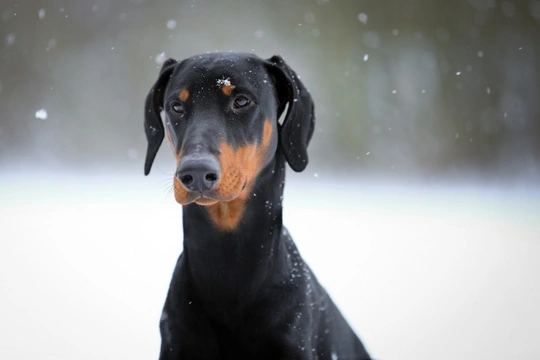
The Doberman and Cervical Disc Disease
The Doberman is a proud looking dog that was first bred as a working and guard dog in Germany, but over the years they have become popular companion dogs as well as watch dogs the world over and for good reason. A Doberman is a loyal and courageous friend and one that will guard not only their territory, but the people they love too.
Like so many other pure breeds, the Doberman does suffer from quite a few health disorders, some of which are acquired whereas others are hereditary conditions passed down to puppies from parent dogs. One of the health issues that seems to plague the breed is a condition known as Cervical Disc Disease or Wobbler Syndrome as it is more commonly called.
The condition affects quite a few breeds that boast having larger and therefore heavier heads and longish necks. It is closely related to dogs that put on fast spurts of growth. Great Danes as well as Dobermans are affected by the condition which causes their spinal cord to compress. A dog suffers a lot of pain in their necks which as a result means they lose a lot of co-ordination in their back legs. In short, it is disease that affects a dog's spine which affects nerve signals between the dog's brain and their body.
Abnormalities in the Bone
Affected dogs have abnormal growth in the bones that make up their intervertebral discs which then rub up against their spinal cord. Over time the condition gets worse and this results in dogs becoming unstable on their feet, hence the term wobbler syndrome"".
A Genetic Disorder
Wobbler Syndrome is known to be a genetic disorder that affects Dobermans which is why if you are thinking about sharing your home with a puppy, it's really important to contact a well-established, reputable breeder who always has all their dogs screened for any hereditary or congenital health disorders before using them in a breeding programme. With this said, studies have also established that diet may also play a part in a dog developing the disorder which is why it's essential that Dobermans be fed a good quality diet to suit their ages throughout their lives.
Symptoms to Watch Out For
As previously mentioned, larger or giant breeds are more predisposed to inheriting or developing the condition which includes Dobermans. Symptoms can manifest themselves at any point in a dog's life although it is more typically when a Doberman reaches midlife that the first signs of there being something wrong first appear and these depend very much on the severity of their condition. The signs to watch out for include the following:
- Dogs develop an uncoordinated gait
- They tend to stumble a lot and as a result scuff their paws
- Occasionally, dogs show a lot of discomfort in their necks although this is not always that evident
- Affected dogs lose all co-ordination in their hind legs and as the condition worsens they become paralysed on all four legs.
Diagnosing the Problem
There are quite a few other health issues that have similar symptoms to those of Wobblers Syndrome which can make it hard for vets to successfully diagnose the problem. These include the following:
- A fracture to a spine
- Spinal cord tumours
- Congenital abnormalities
- Blood clotting health issues
- Meningitis
- Specific infections associated with parasites
A vet would need to take a MRI scan to determine whether or not a dog's intervertebral discs are the cause of the problem. They would then need to carry out an CT scan which would show the shape of a dog's vertebral column bones. Occasionally, a vet might need to carry out other tests which includes taking some spinal cord fluid in order for it to be analysed in a laboratory.
Treating Wobbler Syndrome
When it comes to treatments, this largely depends on the severity of a dog's condition and as such a vet would refer a case to a neurology specialist who would recommend the right treatment for a dog suffering from Wobbler Syndrome. With this said, a vet might advise an owner manages their dog's condition without the need for surgical intervention especially if their condition is not that serious. This would mean a dog would need to undergo long-term physical therapy. Other non-invasive surgical therapies could include the following:
- Complete rest initially, followed by a closely monitored exercise routine
- Dogs may be prescribed anti-inflammatory drugs
- Manipulative therapies
- Laser therapy
- Ultrasound therapy
- Hydrotherapy
However, if the condition is more severe a vet would recommend a more invasive treatment to correct the problem within a dog's spine. Fortunately, with the wonderful advancement in veterinary medicine over the last few decades, these procedures are much safer and more effective than they ever were in the past and the success rate has increased as a result.
The Importance of Rehabilitation
Whether a Doberman has received non-surgical treatment or not, it's crucial for them to undergo rehabilitation so they build up strength which in turn means they are more coordination and balance on their feet again. A veterinary physiotherapist would be able to identify any weaknesses and then work on these so that a dog's quality of life remains high. They would also be able to advise an owner on the amount and sort of exercise a dog should be given during the rehabilitation period.
""



